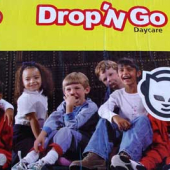
From streakers to tattoos to crop circles, it seems in recent years there's been a big increase in using what was once considered non-mainstream art in advertising. Sometimes it's the whole concept. Sometimes it's the just media.
Recently Time had graffiti artist Cope2 create an outdoor ad for the magazine in Soho. (above)
The Raw Prawn writes about McDonald's using graffiti in an attempt to woo the Latino market in the US. Why graffiti?
"We wanted something [that reflects] the lifestyle of the Hispanic consumer," says Ken Ebo, the chain's regional marketing director.
The graffiti was created by Tats Cru, who also created a mural for Coca Cola and some graffiti art for the Hummer H3, which was defaced by, yup, graffiti.

Then there's CriticalMassive who did some graffiti ads for Axe Deoderant in Chicago. That turned into a bit of an incident though as the graffiti was covered up and it all sounds very confusing. More here and here.
In November of last year, there was uproar in Singapore about a Nike guerilla campaign. We also saw some Levi's 501 graffiti ads in Norway.

In August of 2003 it appeared billboards for the Nissan Altima were being vandelized with spray paint and "Electric Moyo.com". But it ended up being just a way for Nissan to try to show themselves as hip.
There was a similar thing a few months later for Napster. Right before their relaunch posters were put up, bland and boring, and then eventually stickered with the Napster Cat.
It's interesting to note though, that in the golden age of advertising, this wasn't all that uncommon. Many ads were painted on the sides of buildings. It's really very similar and not all that new or revolutionary of an idea.
But now there's also clean or reverse graffiti where the artist uses a cleaner of some sort to remove the grime of the streets, walls, etc to create. One of the most popular folks doing this is a British street artists who goes by "Moose". He's done work for HP (which won the 2004 Interactive Marketing and Advertising Award's Grand Prix), XBox, and Big Brother.

The French Yellow Pages (PagesJaunes) used a similar technique in their promotion for their 2005 edition.

I have a feeling I've seen guerilla ads like this before for a laundry detergent, where the sidewalk was cleaned into the shape of a shirt, but I wasn't able to find any info on this.
Although sidewalk advertising doesn't always go over well. Just ask NBC or IBM. Last July NBC had teasers stenciled on the sidewalks across San Francisco advertising an upcoming TV show. They should have known they were going to get in hot water after IBM Linux did something similar in April of 2001, stenciling logos all over the sidewalks in San Francisco, which peeved off city officials. They were a part of Ogilvy&Mather's "Love, Peace & Linux" campaign.

In a twist on this sort of advertising, TBWA/Paris' outdoor ads for K2R Stain Remover (which have won awards all over the place), use the dirt and oil stains of the pavement in another way.





Ariel also used a somewhat similar concept with their outdoor campaign with posters that were coming off dirty walls to reveal a clean background.

Somewhat more bizarre is the newish use of crop circles as advertising. Circle Makers in the UK have created a large number of advertisements, for big name brands. Like this one for Nike which was done in a field in Milan.

Recently, Lynx placed an ad under Gatwicks flight path. Although this ad, created by BBH and Flightpath Media, is painted, not pressed out or mowed.

The artwork, which mimics the design of the Cerne Abbas Giant -- the chalk man carved in-to a Dorset hillside -- is likely to attract criticism from watchdogs. Because they have an adult theme, the company has been ordered to show the TV ads only after 9pm.
It will be interesting to see what happens with the field-ad. If they had to hide it before 9pm too, how would they accomplish it? Throw a tarp over the 100,000 field during the day? Light it up to be viewed in the dark? ;-)
Researcher.se also points out one in Sweden for the Swedish Rail. Apparently though, this isn't new. Back in 1998, there was this one for Hamlet Cigars. (Gotta love that they included the copyright symbol too.)
Tattoos are also becoming common place in advertising. First it was just that they were used in ads, like Pony's print campaign and BK's tv spot, and famously on childrens foreheads in the Outpost.com 1998 superbowl ad, a foreshadowing perhaps? Later we saw temp tattoos on boxers and on childrens foreheads.

But now we're seeing people selling their bodies or parts of their bodies as ad space to the highest bidder, over and over and over again.
Does all this mean that this non-traditional media is becoming traditional? Are tattoos now mainstream media? Probably not. But, the point of using these mediums, usually, is to stand out, be different, etc. And if everyone is doing it, how do you stand out? If corporate culture is embracing the non-traditional, will it change how effective it is on the target which is usually less responsive to traditional media?





Aaah, you hamsterer of fun ads you. I love it.
When it comes to those field ads, I do recall that there was a giant field showing a Douwe Egbert coffee-pack which could be seen when you landed at Shipol airport a buncha years back (like 97-98). It was well executed, impressed me when I saw it, with several colors in the pack and everyuthing. However, that Axe/lynx man for example, and the SJ (Swedens/State Railway) ad that researcher points out which shows that one could have taken the train cheaper to anyone flying above - and even that Hamlet field-ad actually - have what the DE field ad lacked. A clear idea. I the case of DE, and a bit for Nike in that Milan field, it seems that the "media" is the idea.
Right now there is actually a "field-art" competition gping on in southern Sweden where the winning farmer gets a fat cash prize. Lots of farmers joined in, making complicated field-art like music notes, giant letters, huge flowers and even alien-heads! :)
- reply
PermalinkWhile researching for the article I had also come across this, which is similar to that "field-art" you're talking about.
Farmers in Japan created art in their rice patties by growing different colored rice plants.
- reply
PermalinkInteresting examples of street art ads, thanks caff. I can add that Pepsi Max made a terrible attempt at being cool with a nonsense street-art campaign in Sweden. Unlike the Bamboo (?) underwear ad that Kirshenbaum and Bond did so many years ago, where it read "from here it looks like you can use some new underwear", this ad was defacing a sidewalk without making a point. The ads rad:
Forget something? (Pepsi MAX logo) Don't worry. That's no sugar.
I still can't figure out what the hell that means or why it had to be spraypainted all over the streets.
- reply
PermalinkIn 1995 or whenever that Kirshenbaum Bamboo ad was, it wasn't just the new media that made it stand out - it was also the fact that it had an idea in it. Just like any great poster or TV commercial in a cluttered media environment. The K2r are quite good as well, but I wonder how many will understand the Ariel ones. In my town they might be overlooked simply because posters are half-torn most of the time.

I think the risk is that they let the media itself become the idea, which it can never be no matter how cuttng edge.
Another risk is that this constant ad creep starts grating on the consumers, why should they look on the pavement when the genius Bamboo lingerie message has now been replaced by nonsense Pepsi max advert? Will they take offence as they look out the airplane window to view the landscape and instead get lambasted with ads on every field? Isn't it just a tad ironic that the street art and grafitti which developed in response to sponsored messages being everywhere in public space but the publics voice was never heard is now co-opted to carry the sponsored messages?
- reply
PermalinkAnd with ad creep, will people become more oblivious to the messages as much as any other? Just like you mentioned, Bill, there's less of a reason for people to look at these ads if they are constantly out there. Unless the idea is brilliant and really stops people, just the fact that you're using an outdoor medium or non-traditional medium isn't/won't be enough.
I also wonder if, especially with the graffiti, as more and more traditional and mainstream companies start to use that, will it stop being considered so "anti-establishment" (at least in terms of advertising)? Will those they are trying to reach within urban circles reject the brands completely because these corporate giants are so fakely trying to be hip?
The other thing I find interesting about this surge in these types of media is lately it seems so many advertisers are hung up on numbers and figures and measureable results. And yet, how do you know if a graffiti or field ad is reaching your target? Does someone stand there counting the number of people who check out the ads? Or is the whole measureable aspect just more fodder for the tv vs online battle?
- reply
PermalinkMy pleasure. That Pepsi ad sounds terrible. I don't get it either.
- reply
PermalinkMake that three people who don't get it. What was the point of spraying that on the streets?
- reply
Permalink